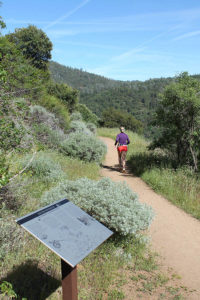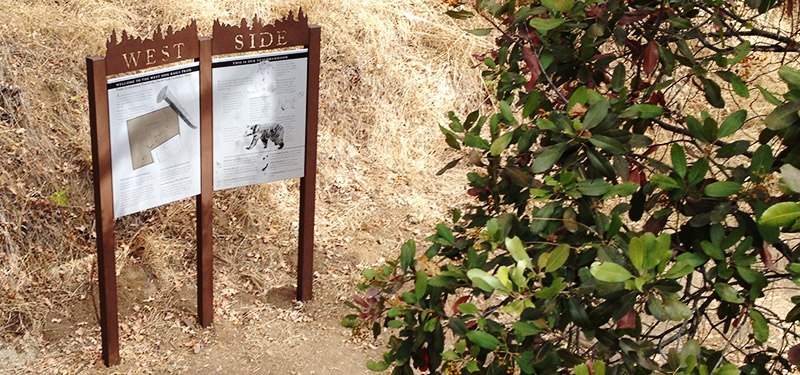Community Collaboration Brings New Life to Favorite Trail
Along the canyon wall above the North Fork of the Tuolumne River, a unique, highly-accessible public trail winds for five miles through the Sierra Nevada Mountains. Offering stunning vistas of the river below, up-close, spring wildflower encounters, and views of distant mountain ridges which beckoned gold miners and timber barons of the past, the recently revamped trail now also connects fascinating local history with an easy hike and family recreational opportunity.
The trail sits atop the former site of the Hetch Hetchy & Yosemite Valley Railroad, constructed in 1898 and in operation as a narrow gauge rail line serving the timber industry until the late 1960s. The recent upgrades to the Westside Trail were spearheaded by the 3 Forest Interpretative Association (3FIA) and a diverse collection of collaborators, working in partnership to create and installed a series of interpretive panels and signs along this historic stretch of railroad grade.
In one panel entitled ‘Fire,’ a period photograph of a fire lookout, bold graphics of locomotive wheels grinding metal on metal, and an engaging narrative combine to recreate a sense of the fears and dangers of wildfires in the past. Another panel displays detailed line drawings of native plants and Me-Wuk handiwork while relating the tensions and disparities between the Native and European cultures when the logging industry was booming, and Indian cultures suffered.
 Beginning in 2012 when the Federal Highway Administration scheduled improvements to the adjacent roadway, 3FIA began working with the U.S. Forest Service, Bureau of Land Management, the Me-Wuk Indian Tribe, Tuolumne Park and Recreation District, and Tuolumne County Transportation Council to implement the project. The trail crosses land belonging to many of these groups, as well as private landowners. The Tuolumne County Historical Society, Carlo M. DeFerrari Archive, the Tuolumne City Memorial Museum, and trail enthusiasts also contributed to the effort.
Beginning in 2012 when the Federal Highway Administration scheduled improvements to the adjacent roadway, 3FIA began working with the U.S. Forest Service, Bureau of Land Management, the Me-Wuk Indian Tribe, Tuolumne Park and Recreation District, and Tuolumne County Transportation Council to implement the project. The trail crosses land belonging to many of these groups, as well as private landowners. The Tuolumne County Historical Society, Carlo M. DeFerrari Archive, the Tuolumne City Memorial Museum, and trail enthusiasts also contributed to the effort.
The signs are constructed of rugged, anodized aluminum, enhancing the historic railroad theme of the display. Computer graphics interns from Columbia College made numerous trips to the site and local historical archives to unearth real-life stories and accurate details about the railroad’s history. A special effort was made to ensure the information on the panels does not duplicate information published elsewhere. On National Public Lands Day in September 2013, volunteers installed the first panels. The Tuolumne West Side trail is part of a more extensive, state-wide trail system under construction.
Project contributors sought to highlight for the enjoyment and edification of hikers, bicycle enthusiasts, and horseback riders the cultural heritage preserved in this historic stretch of old railroad grade. The project enhances a trail following the last of the timber industry’s steam-powered, narrow-gauge railroad lines to operate in the West.
The West Side Trail’s history as a vital access route to logging camps deep inside the Stanislaus Forest in the 19th and 20th centuries has made this site eligible for the National Registry of Historic Places for its significant insight into the early history of the timber industry in California.
Learn more at the official project website and USFS Rails to Trails page.


